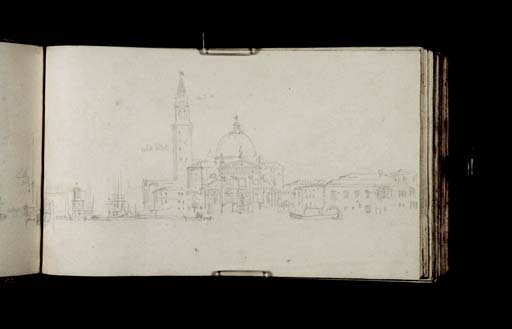Joseph Mallord William Turner The Isola di San Giorgio Maggiore, Venice, with the Church and Campanile 1819
Image 1 of 2
Joseph Mallord William Turner,
The Isola di San Giorgio Maggiore, Venice, with the Church and Campanile
1819
Joseph Mallord William Turner 1775–1851
Folio 66 Verso:
The Isola di San Giorgio Maggiore, Venice, with the Church and Campanile 1819
D14442
Turner Bequest CLXXV 66a
Turner Bequest CLXXV 66a
Pencil on white wove paper, 112 x 185 mm
Inscribed by Turner in pencil ‘Red W’ and ‘White Edges’ above left of centre, on either side of campanile
Inscribed by Turner in pencil ‘Red W’ and ‘White Edges’ above left of centre, on either side of campanile
Accepted by the nation as part of the Turner Bequest 1856
References
1909
A.J. Finberg, A Complete Inventory of the Drawings of the Turner Bequest, London 1909, vol.I, p.514, CLXXV 66a, as ‘Isola di S. Giorgio Maggiore’.
1930
A.J. Finberg, In Venice with Turner, London 1930, pp.37, 165, as ‘S. Giorgio Maggiore from the Dogana. “White Edge” (referring to windows in tower which are edged with white stone[)]’, pl.IV, as ‘S. Giorgio Maggiore from the Dogana’.
2003
Ian Warrell in Warrell, David Laven, Jan Morris and others, Turner and Venice, exhibition catalogue, Tate Britain, London 2003, pp.88 and 263 note 6.
2008
Ian Warrell, ‘The Approach of Night: Turner and La Serenissima’ in Martin Schwander, Bozena Anna Kowalczyk, Warrell and others, Venice: From Canaletto and Turner to Monet, exhibition catalogue, Fondation Beyeler, Riehen 2008, pp.57, 67 note 3.
2014
Ian Warrell, Turner’s Sketchbooks, London 2014, reproduced in colour p.105, as ‘The Island of San Giorgio Maggiore’.
Inverted relative to the sketchbook’s foliation, the view is east-south-east across the Bacino to the west front of the church of San Giorgio Maggiore, on the island of the same name, and is continued briefly on folio 67 recto opposite (D14443). The carefully articulated alignment of the various buildings indicates a viewpoint at the entrance to the Grand Canal, off the Punta della Dogana. Finberg subsequently annotated his 1909 Inventory entry (‘Isola di S. Giorgio Maggiore’): ‘S. Giorgio from the Grand Canal’.1 In another copy he wrote: ‘from Dogana’.2 The Turner scholar C.F. Bell annotated another copy: ‘from a point facing the front of the church’.3
Finberg subsequently suggested the viewpoint was the same as that for the view of the church of the Madonna della Salute on folio 54 verso (D14417), outside the Palazzo (or Ca’) Giustinian.4 He noted: ‘If it is my duty to find faults where I can, I will admit that I think the size of the dome is exaggerated. Apart from this the drawing to me seems perfect of its kind’.5
While Lindsay Stainton has observed6 that Tate D15254 (Turner Bequest CLXXXI 4), a watercolour of San Giorgio in the contemporary Como and Venice sketchbook, together with another showing the Dogana, Tate D15256 (Turner Bequest CLXXXI 6), effectively form a panorama foreshadowing the oil painting The Dogano, San Giorgio, Citella, from the Steps of the Europa, exhibited at the Royal Academy in 1842 (Tate N00372),7 Ian Warrell has noted that this drawing, in conjunction with other pages in this sketchbook showing views effectively following on to the right on folios 40 recto and 54 verso (D14389, D14417), could have been utilised.8 The comparative inaccuracies of D15254 in proportion and detail might suggest it was done spontaneously to catch the effects of light and atmosphere, rather than following the present pencil outline.
Matthew Imms
March 2017
Undated MS note by A.J. Finberg (died 1939) in interleaved copy of Finberg 1909, Tate Britain Prints and Drawings Room, I, opposite p.514.
Undated MS note by Finberg in copy of Finberg 1909, Tate Britain Prints and Drawings Room, I, p.514.
Undated MS note by C.F. Bell (died 1966) in copy of Finberg 1909, Tate Britain Prints and Drawings Room, I, p.514.
See Warrell 2003, pp.88 and 263 note 6, citing Lindsay Stainton, Turner’s Venice, London 1985, p.42.
How to cite
Matthew Imms, ‘The Isola di San Giorgio Maggiore, Venice, with the Church and Campanile 1819 by Joseph Mallord William Turner’, catalogue entry, March 2017, in David Blayney Brown (ed.), J.M.W. Turner: Sketchbooks, Drawings and Watercolours, Tate Research Publication, July 2017, https://www


